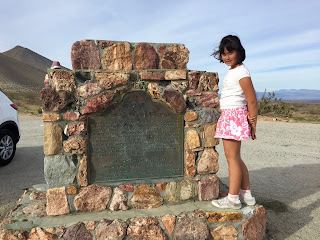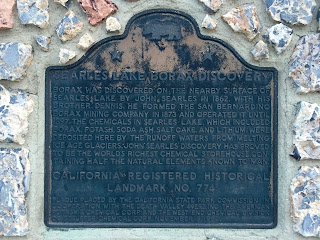Due to school starting we had to take a little break from our CHL adventures, but now we are back on track! We decided to do a day trip to Kern County to see Willow Springs (CHL 130).
This spring was visited by several parties traveling through California-- Padre Garces, the Jayhawk Party, and operated as a stage station on the Inyo Lines.
Our next landmark for the day was in front of a deserted restaurant building, the 20-Mule Team Borax Terminus (CHL 652).
The borax wagons traveled from here to Death Valley from 1884-1889.
We next found Desert Spring (CHL 476). This is one of the most important sites in the desert--a water spring!
According to the state: This spring was on an old Indian horse thief trail and later (1834) Joe Walker Trail. The famished Manly-Jayhawk Death Valley parties (1849-50) were revived here after coming from Indian Wells through Last Chance Canyon. This was also a station on the Nadeau Borax Freight Road.
You can actually still see the remnants of a spring here-- which is pretty cool!
Our path next brought us to Freeman Junction (CHL 766).
The plaque reads:
In 1834 explorer Joseph R. Walker passed this junction of Indian trails after discovering nearby Walker Pass. Death Valley 49er parties here diverged west and south after their escape from Death Valley enroute to the California gold fields. Later this became a junction point where the bandit Tiburcio Vasquez preyed on stages and freighters traveling between the Kern River mines and Los Angeles and the mines of Bodie and the Panamints.
Now this plaque just seems to be target practice for local teens.
A short drive into the hills brought us to Walker's Pass (CHL 99).
On the plaque: Discovered by Joseph R. Walker, American trail-blazer, who left the San Joaquin Valley through this pass in 1834. This area was traversed by topographer Edward M. Kern, after whom the Kern River was named, while accompanying the Frémont expedition of 1845. After 1860 it became a mining freight route to Owens Valley.
Happily there is an additional plaque here for Joseph Walker! He was a true mountain man who spent most of his life exploring, charting and guiding people through California. Interesting to note-- this pass is essentially the same as it was when he discovered it. I think the only difference is that it is now a paved road.
Our next stop for the day was Indian Wells (CHL 457).
From the state: After five days' travel from the Argus Range, the Manly-Jayhawker parties of 1849 found their first water at this Indian waterhole on the Joseph R. Walker Trail of 1843. During the 1860s, this was the site of a stage and freight station for traffic between Los Angeles and the Coso and Cerro Gordo Mines.
Indian water hole on Joseph R. Walker trail of 1834 where Manly-Jayhawker parties of 1849 found their first water after five days of travel from Argus Range. During 1860's was site of stage and freight station from Los Angeles to Coso and Cerro Gordo mines.
Site of the Town of Garlock (CHL 671) was our next stop as we raced the sun to hit all of our spots before night-fall.
The guidebook says: In 1896, Eugene Garlock constructed a stamp mill near this spot to crush gold ore from the Yellow Aster Mine on Rand Mountain. Known originally as Cow Wells by prospectors and freighters during the 1880s and early 1890s, the town of Garlock continued to thrive until 1898, when water was piped from here to Randsburg and the Kramer-Randsburg rail line was completed.
In a small community in the middle of nowhere, we found the Rand Mining District (CHL 938).
The guidebook says: The Yellow Aster, or Rand mine was discovered in April 1895 by Singleton, Burcham, and Mooers. The town of Randsburg quickly developed, followed by the supply town of Johannesburg in 1896. Both names were adopted from the profusion of minerals resembling those of the ranch mining district in South Africa. In 1907, Churchill discovered tungsten in Atolia, used in steel alloy during World War I. In June 1919, Williams and Nosser discovered the famous California Rand Silver Mine at Red Mountain.
For our final site we left Kern County and headed to San Bernadino County to hit Trona and the Searles Lake Borax Discovery (CHL 774).
This was our first visit to Trona-- which was very short due to the setting sun. The only thing we noticed about the town was a distinct smell.
The guidebook says the site is significant for the following reasons: Borax was discovered on the nearby surface of Searles Lake by John Searles in 1862. With his brother Dennis, he formed the San Bernardino Borax Mining Company in 1873 and operated it until 1897. The chemicals in Searles Lake, which included borax, potash, soda ash, salt cake, and lithium, were deposited here by the runoff waters from melting ice age glaciers. John Searles' discovery has proved to be the world's richest chemical storehouse, containing half the natural elements known to man.
And there ends another day of adventuring to track down all of the California historic landmarks.









































































